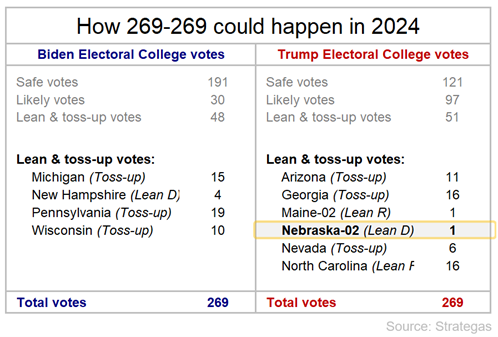
Washington Policy Research
Strategas’ award-winning Washington Policy Research team studies the interaction between policy, elections, and financial markets. Their monthly report aims to assess how recent policy developments in trade, tax, healthcare, energy, and other initiatives impact the economy and markets.
Return to Market InsightsAn Electoral College Tie is Possible in 2024
Close elections have become the norm in recent years, and there’s a risk that neither major party candidate gets the requisite 270 Electoral College votes this November. That would mean the newly elected House chooses the president, a scenario that hasn’t happened since 1824.
The last two presidential elections were decided by three states and fewer than 80,000 voters in each case. We expect the 2024 election to be close as well, with a chance that neither Joe Biden nor Donald Trump receives 270 Electoral College votes, the threshold to win the presidency. The risk is not due to the emergence of several third-party and independent candidates. Those candidates could peel voters away from Biden or Trump and impact who wins a state in a close race, but they aren’t likely to win a state outright and secure Electoral College votes. Instead, we believe the risk is that we end up with a 269-269 Electoral College tie.
There are seven swing states this cycle: Arizona, Georgia, Michigan, Nevada, North Carolina, Pennsylvania, and Wisconsin. If Biden wins Michigan, Pennsylvania, and Wisconsin, which he won in 2020, he would have exactly 270 Electoral College votes if he also wins all of the other electoral votes that he won in 2020. This count includes Nebraska’s 2nd congressional district (Omaha) because Nebraska (along with Maine) allocates Electoral College votes by district as well as by statewide vote. In this scenario, Trump would have 268 votes. However, if Trump were to flip Nebraska’s 2nd district, that would take one vote from Biden’s column, resulting in a 269-269 split. Although Biden won that district in 2020, Trump won it in 2016.

If no candidate receives 270 Electoral College votes, a contingent election will occur. In a contingent election, the newly elected House of Representatives decides who will be the president among the top three Electoral College vote-getters for the presidency and the newly elected Senate decides who will be the vice president between the top two Electoral College vote-getters for that office. In the Senate, each member has a vote. In the House, each state’s delegation receives one vote. This means that even if Republicans lose all of the 17 districts they are defending that voted for Biden in 2020 and Democrats lose all five districts they are defending that voted for Trump in 2020, Republicans will still have control of 26 state delegations, a simple majority. In this scenario, losing a net 12 seats would mean that Republicans lose control of the House and are the minority party but still have the opportunity to choose a Republican president.
The contingent election vote would not take place until January, when the new Congress is seated. That means we could have two months of not knowing the election outcome, which could lead to market weakness. Notably, in 2000, the Federal Reserve did an emergency 50 basis point rate cut because the US economy that year was slowing into the election and the slowdown was compounded by not knowing the presidential election winner for six weeks. While this scenario is unlikely, we will be watching closely as the race evolves.
This is not a complete analysis of every material fact regarding any company, industry or security. The opinions expressed here reflect our judgment at this date and are subject to change. The information has been obtained from sources we consider to be reliable, but we cannot guarantee the accuracy.
This report does not provide recipients with information or advice that is sufficient to base an investment decision on. This report does not take into account the specific investment objectives, financial situation, or need of any particular client and may not be suitable for all types of investors. Recipients should consider the contents of this report as a single factor in making an investment decision. Additional fundamental and other analyses would be required to make an investment decision about any individual security identified in this report.
For investment advice specific to your situation, or for additional information, please contact your Baird Financial Advisor and/or your tax or legal advisor.
Fixed income yield and equity multiples do not correlate and while they can be used as a general comparison, the investments carry material differences in how they are structured and how they are valued. Both carry unique risks that the other may not.
Past performance is not indicative of future results and diversification does not ensure a profit or protect against loss. All investments carry some level of risk, including loss of principal. An investment cannot be made directly in an index.
Strategas Asset Management, LLC and Strategas Securities, LLC are affiliated with Robert W. Baird & Co. Incorporated, a broker-dealer and FINRA member firm, although the firms conduct separate and distinct businesses.
Copyright 2024 Robert W. Baird & Co. Incorporated.
Other Disclosures
UK disclosure requirements for the purpose of distributing this research into the UK and other countries for which Robert W. Baird Limited holds an ISD passport.
This report is for distribution into the United Kingdom only to persons who fall within Article 19 or Article 49(2) of the Financial Services and Markets Act 2000 (financial promotion) order 2001 being persons who are investment professionals and may not be distributed to private clients. Issued in the United Kingdom by Robert W. Baird Limited, which has an office at Finsbury Circus House, 15 Finsbury Circus, London EC2M 7EB, and is a company authorized and regulated by the Financial Conduct Authority. For the purposes of the Financial Conduct Authority requirements, this investment research report is classified as objective.
Robert W. Baird Limited ("RWBL") is exempt from the requirement to hold an Australian financial services license. RWBL is regulated by the Financial Conduct Authority ("FCA") under UK laws and those laws may differ from Australian laws. This document has been prepared in accordance with FCA requirements and not Australian laws.


